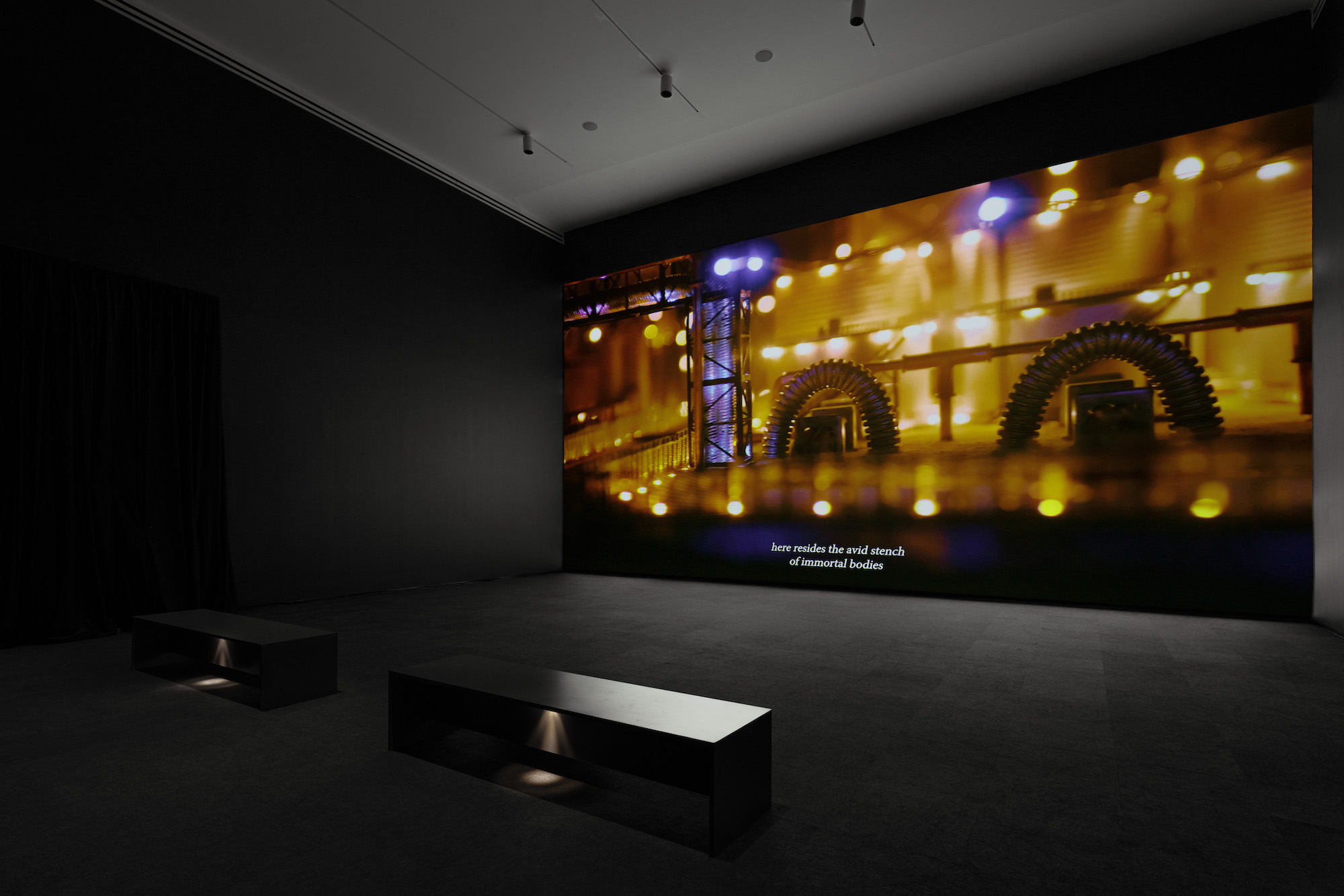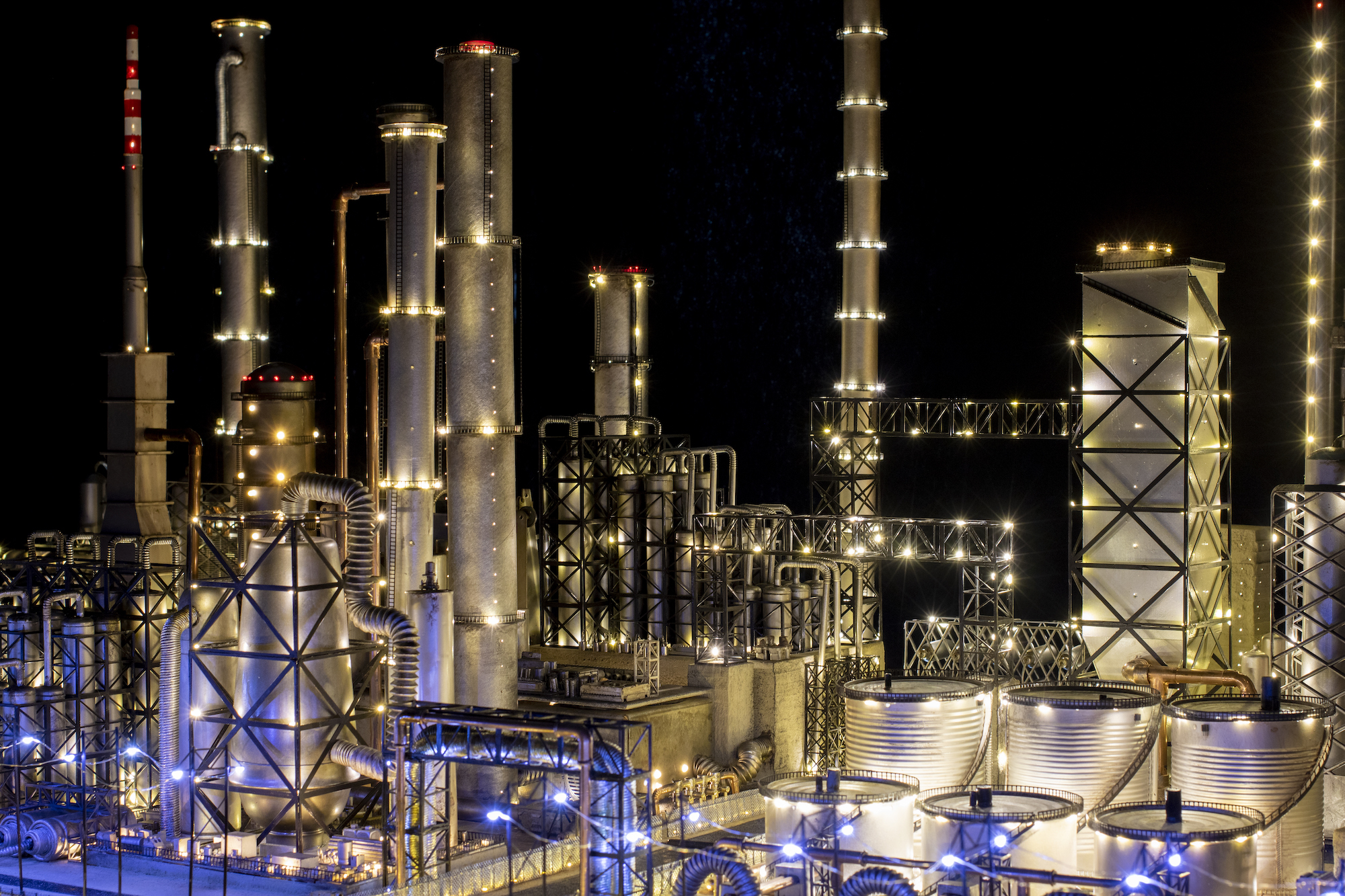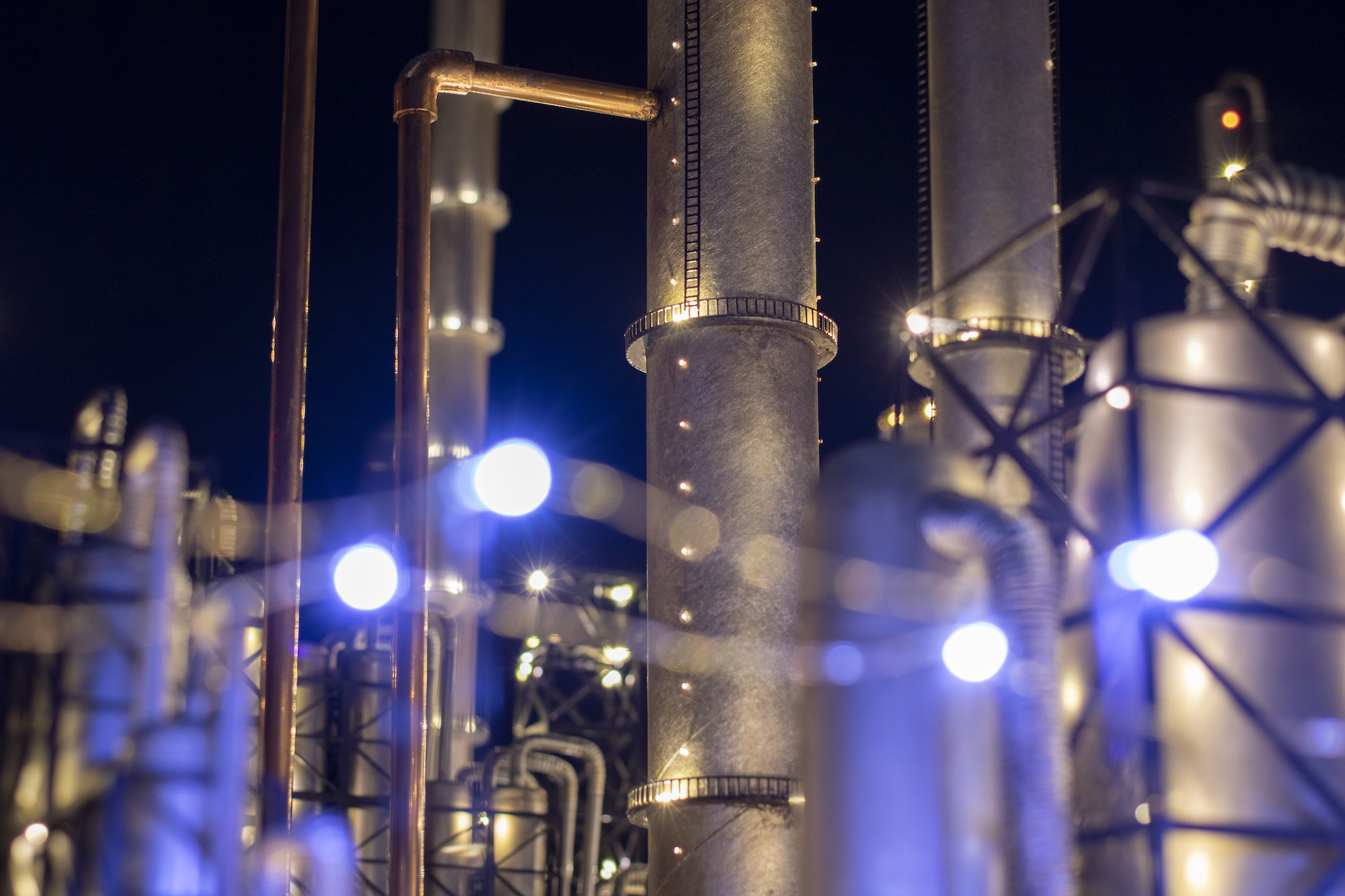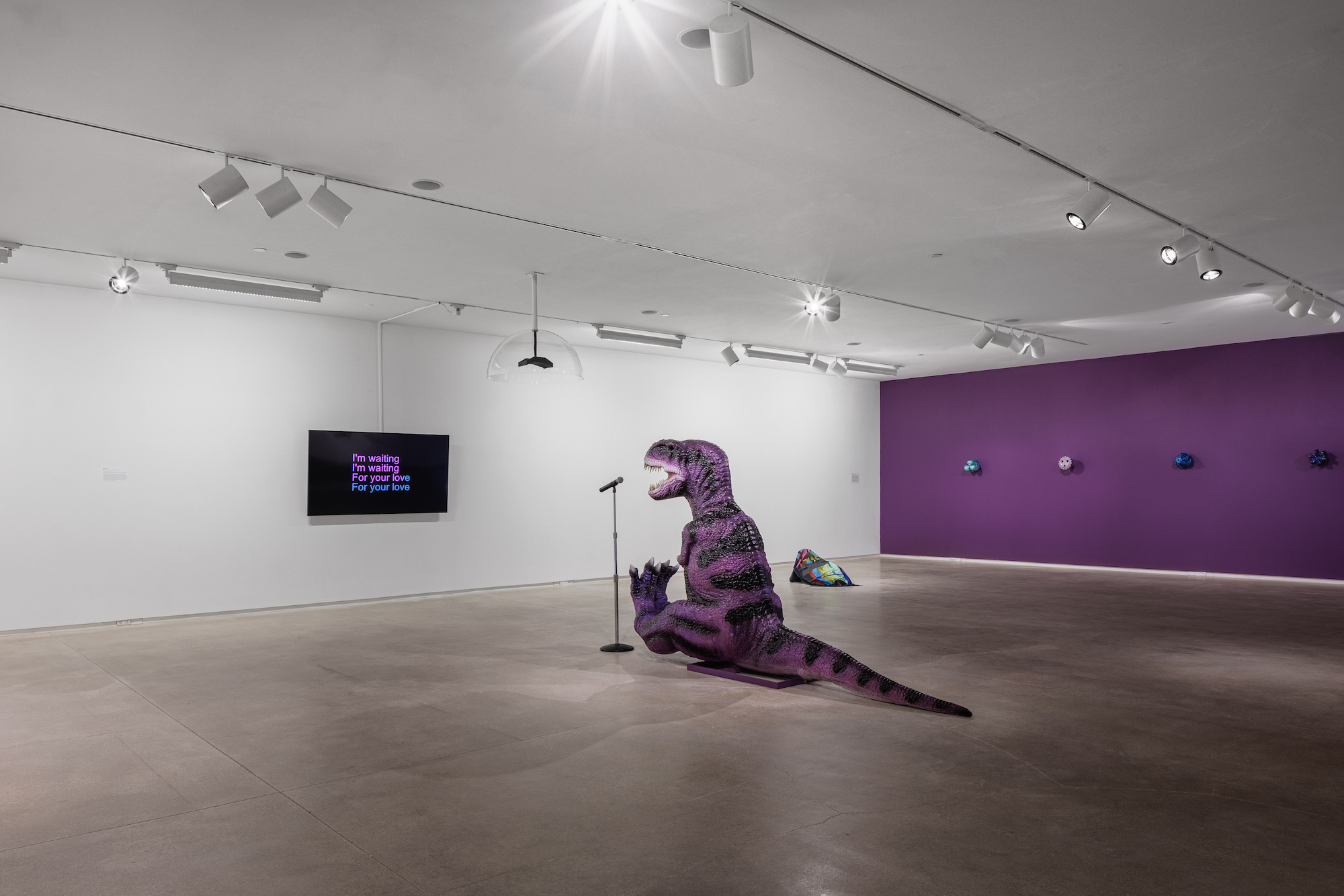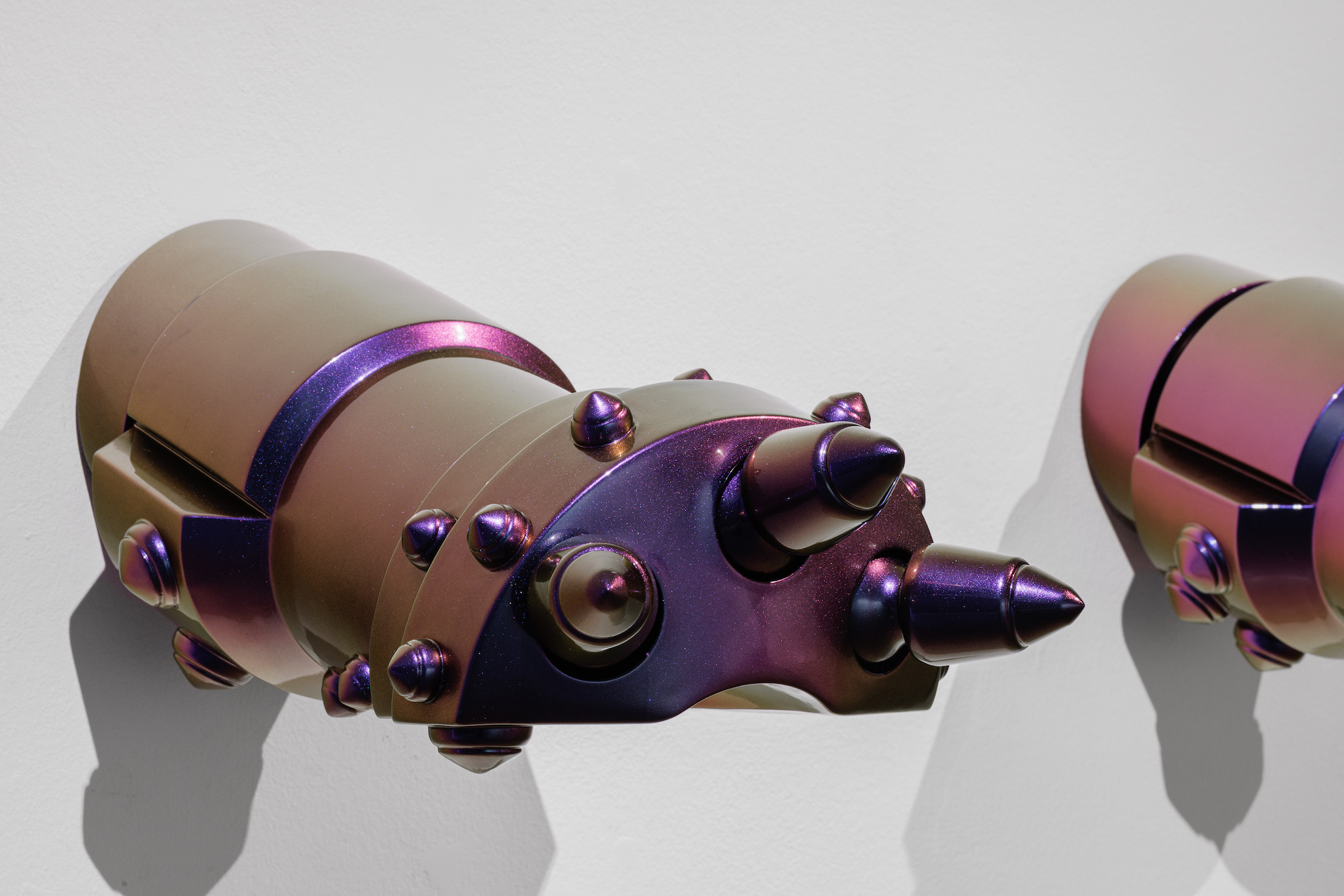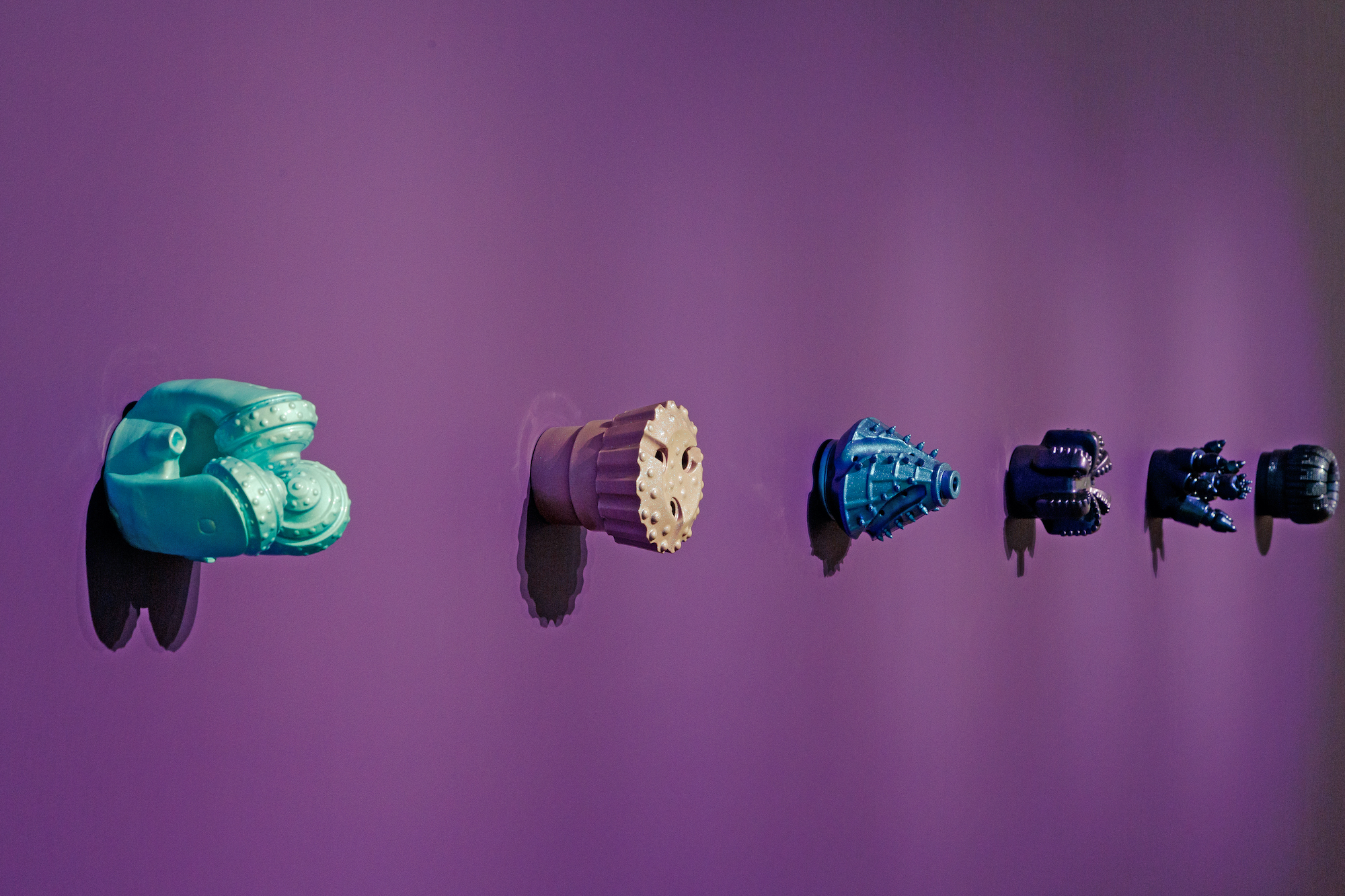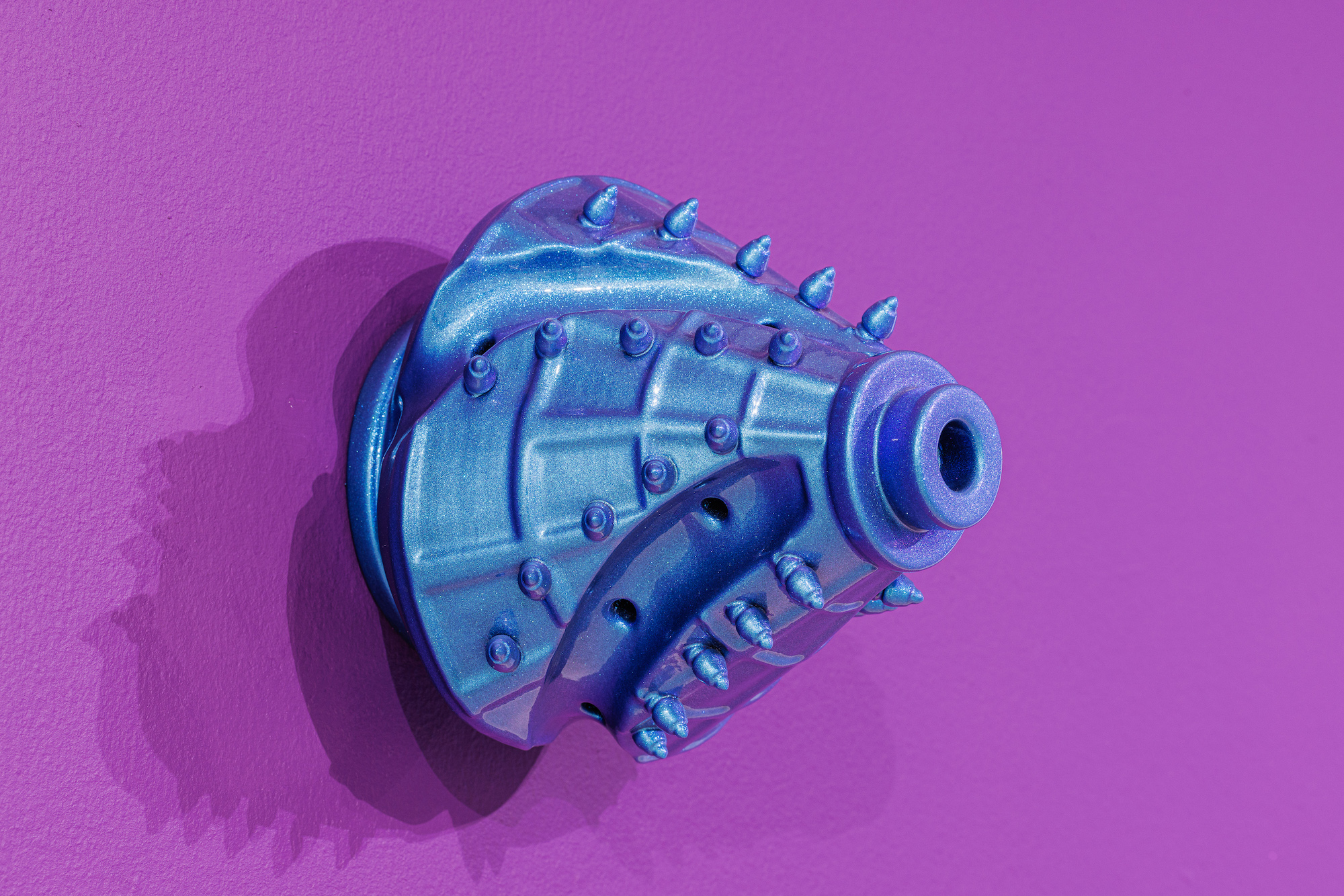
Monira Al Qadiri, Spectrum, 2016, 3D printed sculptures, automotive paint [photo: Francisco Ramos; courtesy of the artist and König Galerie, Berlin]
Monira Al Qadiri: Refined Vision
Share:
Recently spanning the bottom floor of the Blaffer Art Museum was Monira Al Qadiri: Refined Vision, the artist’s first solo museum exhibition in the US, curated by Tyler Blackwell. Al Qadiri’s ability to infuse her work with geographically immediate cultural associations—ones that connect to broader global conditions—stood out as a throughline in the exhibition. She achieved this aspect of her work through evocations of Houston and the Gulf of Mexico as hubs of the oil and gas industry, and with a unique approach to the analysis of “petro-cultures,” a term that here refers to significant and identifiable societal impacts of oil and gas within the makeup of specific cultural fabrics.
A quick glance at Al Qadiri’s biography suggests that she has the life experience to offer reliable knowledge about how the oil and gas industry has shaped diverse cultures, their lands, and landscapes. A keystone to her work can be found during her youth in Kuwait in the 1980s and 1990s, a period of enormous national financial growth and geopolitical upheaval there thanks, in part, to the Middle East region’s oil assets. Whereas fossil fuel exploration happens on a global scale, Al Qadiri zeroes in on extraction and refinement, which are much more visible at ground level in certain regions of the world. This exhibition drew a nuanced connection between the Persian Gulf region and the Texas Gulf Coast (although not noted in the exhibition information, the processing infrastructure of the latter region certainly extends into southern Louisiana).
Monira Al Qadiri, Crude Eye, 2022, single-channel video, sound, 10 minutes [photo: Francisco Ramos; courtesy of the artist and König Galerie, Berlin]
Monira Al Qadiri, Crude Eye, 2022, single-channel video, sound, 10 minutes [photo: Raisa Hagiu; courtesy of the artist and König Galerie, Berlin]
Monira Al Qadiri, Crude Eye, 2022, single-channel video, sound, 10 minutes [photo: Raisa Hagiu; courtesy of the artist and König Galerie, Berlin]
At the entry to the exhibition was Crude Eye (2022), a video work that appears to have been made through a drone survey of a functioning but vacant oil refinery. In southeast Texas and southern Louisiana, massive oil refineries are scattered about the region, never too far from the six-lane highways that serve as throughfares for all manner of capitalist enterprise. This video resonates with the Texas Gulf Region and its residents, and the work effectively communicates the artist’s own personal experiences. What makes the work so striking, though, is that it also captures the enigmatic and otherworldly qualities of such refineries. Throughout my childhood these curious sites were visibly close, yet their activities seemed alien and out of reach. A sense of reality-questioning present in this work is enhanced once one realizes that the video actually shows a miniature refinery—a representation made apparent by cardboard tubes, decorative LED lights, and uncanny camera angles. Ominous yet somehow beckoning, Crude Eye establishes a shared memory with the largely Houstonian audience, and through this work Al Qadiri subtly prepares them to call upon a panoply of other cultural connections.
Monira Al Qadiri, Refined Vision, installation view, 2022 [photo: Francisco Ramos; courtesy of the artist and König Galerie, Berlin]
Refined Vision occupied two drastically different spaces, the towering black box theater wherein Crude Eye was the sole work presented, and, beyond it, a white-cube gallery. Movement between the two spaces proved jarring—like waking from a dream in which fantastical visions that seemed normal then appeared laid out for waking examination. In the gallery a central object—a cartoonish figure of a purple Tyrannosaurus rex—at first distracted from all else. It was a cheeky, even somewhat expected encounter given the context, but the seemingly one-note reference (dinosaurs and fossil fuels) was exquisitely unveiled later. The T. rex is an oblique and generational reminder of go-kart tracks filled with Jurassic themes, plus the pervasive smell of gasoline and barely regulated exhaust sputtering in the faces of children who were all too young to recognize that one day they would drive fast and rely upon cars and trucks to maintain a livelihood. The Blaffer is on the city’s south side, a short distance from the Port of Houston and the now defunct AstroWorld. In Seismic Songs (2022) the mini-dinosaur appeared with a microphone in front of a flatscreen TV, in a loose karaoke tableau. Emanating from a directional speaker were the sounds of an Auto-Tuned voice that followed the words on the screen. From an explanatory label visitors learned that acoustic technologies—specifically signal processing—used in oil and gas exploration were precedents to Auto-Tune in the music industry.
In Spectrum (2016), a series of sculptures was mounted horizontally along a purple wall. The work is an index of organic designs—radially symmetrical, fractalesque, and suggestive of mandalas—though each sculpture is, in fact, based upon types of drill bits used in the oil and gas extraction process. Iridescent automotive paint—with a granular, shimmery visual effect like that of crude oil spilled on the surface of water—applied to this work, and to the kinetic work Jurassic Gauntlet (2022), is a reference to the pearl industry in the Persian Gulf’s coastal region. In this simple and smart gesture, Al Qadiri symbolically spans centuries of resource extraction and insinuates that what was once a place of pearl-culture is certainly now one of petro-culture. This connection then leads to another, more contemporary reference: Houston is home to its own distinct style of automotive modification, “slab culture,” which is deeply rooted in the city’s music scene.
Monira Al Qadiri, Jurassic Gauntlet, 2022, 3D-printed plastic, automotive paint, animatronic applications [photo: Francisco Ramos; courtesy of the artist and König Galerie, Berlin]
Spectrum and the installation RESEVOIR (2019)—in which images printed on fabric showed digital renderings of underground oil reservoirs—highlighted interlocking technological advances for oil and gas exploration and the practical requirements of extraction. But the works also indirectly referenced the vast, hierarchical labor conditions of the industry. For instance, in RESEVOIR, a geologist or geophysicist might have recognized the prints as 3-D stratigraphic maps—tools for reading layers of rock in a given region to locate potential fuel deposits. In Spectrum, meanwhile, an individual who works primarily on site would have a hands-on knowledge of the types and uses of the rendered drill bits. In the video work Behind the Sun (2013) one sees catastrophic results of the first Gulf War conflict in images of ferocious Kuwaiti oil-field fires—images originating in locations far from Houston. There was a political question at hand for visitors to Refined Vision—a question about their awareness of the systems that produce petro-cultures and how viewers themselves might be embedded.
In Refined Vision there were succinct and illuminating explanations of each work that invited visitors to examine the artist’s process, to enter her visual and experiential lexicon that forms a quasi-futuristic narrative, one which carries an underlying statement about the environmental and geopolitical ramifications of petro-cultures. Al Qadiri seems to take an archeological approach to examining petro-cultures, and this exhibition asked the same of its visitors. She pieces together geographically disparate regions, geological epochs, and different disciplines so that they can unfold and establish new associations and perspectives on contemporary issues. It’s as if her manner of forming cultural connections is akin to the dynamic activity of the fossil fuels from which they emerge—flowing, seeping, coalescing, and erupting. Yet the strength and crux of this exhibition fostered desire for more engagement: Refined Vision took place in the deep and layered petro-culture of the US Gulf Coast—Houston, specifically—and with that locale tapped a whole host of new interactions. Perhaps they will unfold programmatically, will be found in the forthcoming catalogue, or emerge in Al Qadiri’s works to come.
Monira Al Qadiri, Spectrum, 2016, 3D printed sculptures, automotive paint [photo: Francisco Ramos; courtesy of the artist and König Galerie, Berlin]
Monira Al Qadiri, Spectrum, 2016, 3D printed sculptures, automotive paint [photo: Tony Elieh; courtesy of the artist and König Galerie, Berlin]
Park Myers has organized projects at 1708 Gallery, Richmond, VA; ICA at VCU, Richmond, VA; Knockdown Center, New York; Actual Size, Los Angeles; Tamanoir, Brussels; Komplot, Brussels; the Judd Foundation, New York; the Hessel Museum of Art, Annandale-on-Hudson; the Copenhagen Art Festival; and the Steamboat Springs Arts Council, Steamboat, CO. Former member of City of Steamboat Springs Public Art Board. Publications include OnCurating Journal, David Horvitz: Newly Found Bas Jan Ader Film (Afterall Books / One Work) [unauthorized] (1708); The Cure (Komplot), and Dear Helen (CCS Bard), Patsy Krebs: Fugue (SSAC), and is a co-founder of the online journal aCCeSsions.
